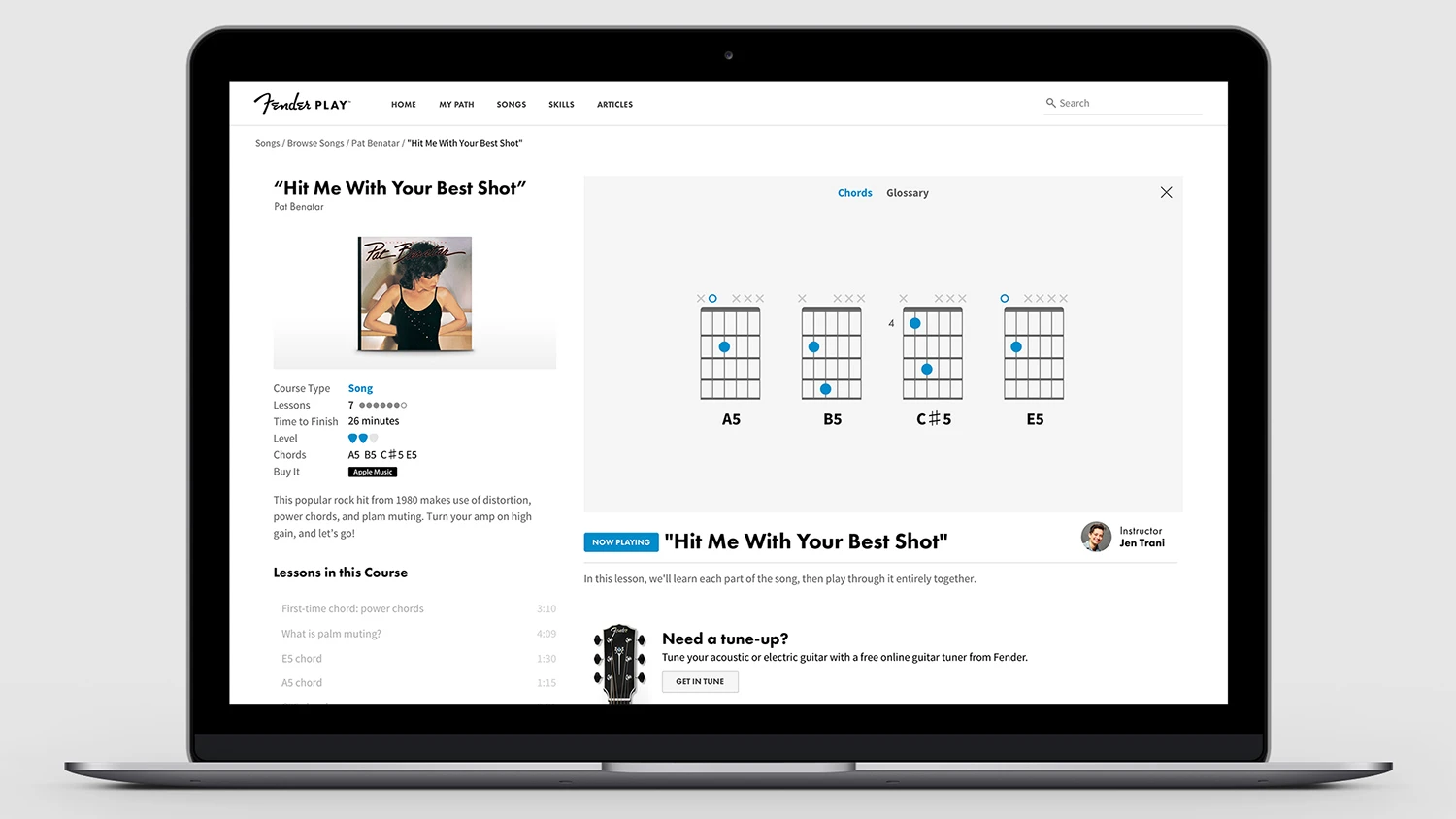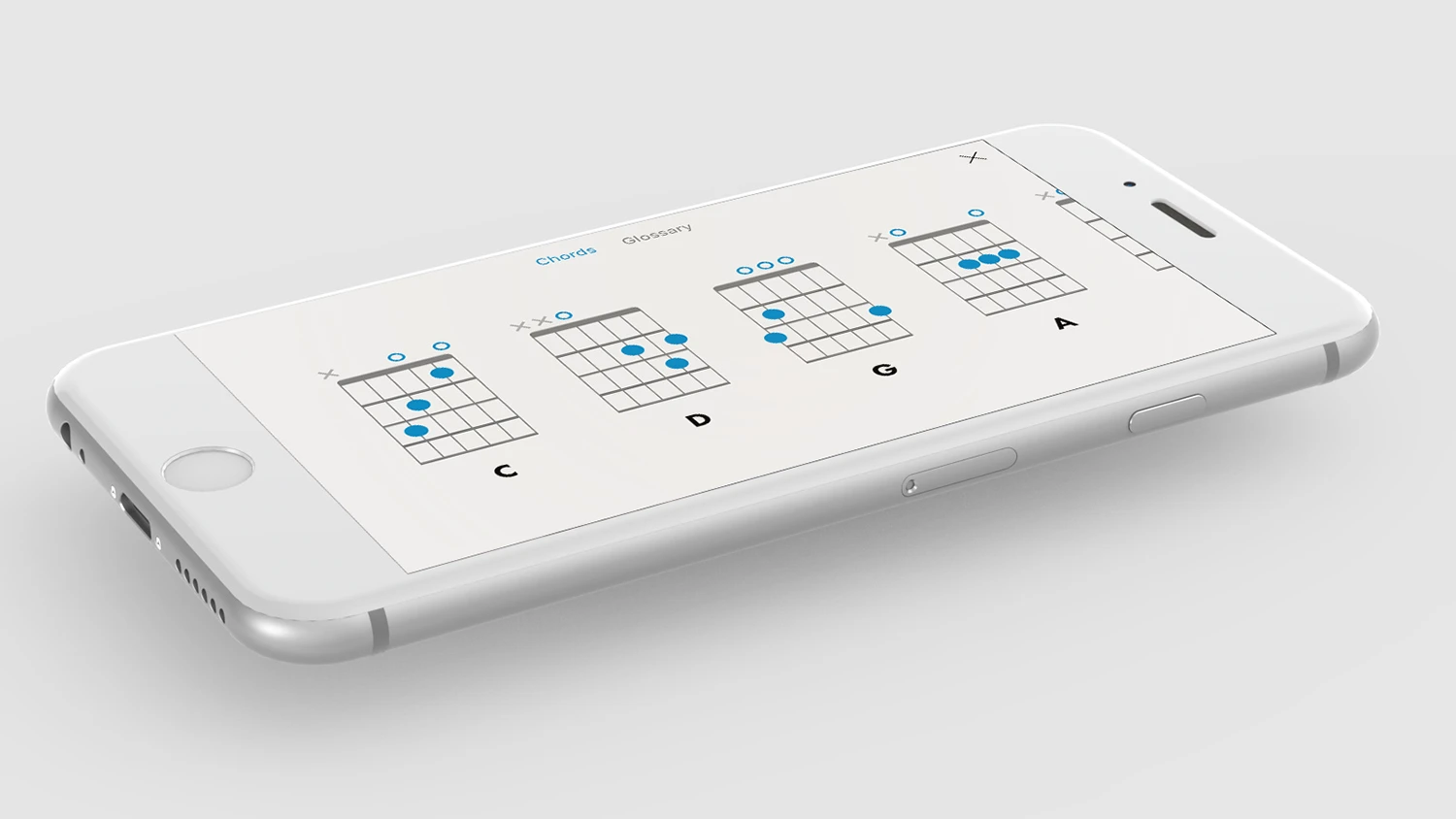No kid ever dreams of growing up and becoming a shitty guitar player. But alas, here I am. I’ve been obsessed with music since elementary school, but apparently the rapid-firing neurons of excitement were no match for whatever else was going on in my attention deficit disordered brain at age 10. I could never muster up the focus required to learn the acoustic guitar my mother bought me, eventually switching to drums. Still, the guitar has always tempted me.
In recent years, learning music has become a much easier, do-it-yourself affair thanks to YouTube tutorials and countless guitar lesson websites. I’ve certainly dabbled with these from time to time, but the quality and accuracy of the videos varies, to put it politely. Recently, I came across a new option.
Fender Play is a video subscription service designed to make learning the guitar online a more painless, digestible process. Using bite-sized, multi-angle video lessons, Fender Play puts the focus on learning popular songs, rather than bogging students down with arcane music theory up front. The idea behind the new $20-per-month service is to more quickly nudge amateurs toward the rewarding milestone of actually being able to play a familiar song. Then, the company hopes, beginners will be less likely to quit—and perhaps more likely to buy more Fender guitars and amplifiers in the future.
“About 45% of the guitars that we sell every year are bought by an absolute beginner,” says Andy Mooney, CEO of the 70-year-old guitar manufacturer. “Somebody who has never touched the instrument before, 90% of those players abandon it within one year.”
I completely understand why. Just as my short attention span rendered the guitar a hopeless, dust-covered endeavor in fourth grade, today we’re all living distracted, busy lives. If you pick up a guitar and don’t feel a sense of accomplishment within a reasonably short stretch of time, there are countless apps on your phone and binge-worthy shows on Netflix that can satisfy our brain’s craving for dopamine.
To help declutter this field of abandoned rock stardom dreams, the team behind Fender Play partnered with prominent music schools in Los Angeles to design a curriculum that jibes with the way people learn in our new, partially digital lives.

“Technology has changed rapidly,” says Fender’s general manager of digital, Ethan Kaplan, who previously worked in tech-oriented roles at Warner Bros. Music and Live Nation. “The way that I learned piano when I was a kid is no longer the way most people learn. They sit at a computer. They sit on an iPhone. They do things in little bites versus sitting through hourlong lessons.”
With the help of a committee of PhDs from schools like the Musicians Institute in Hollywood and the Thornton School of Music at the University of Southern California, Fender designed what it calls a “micro-learning” strategy designed to cater to modern learning styles with a research-backed, personalized pedagogy. The service, which is available on the web and iOS to start, breaks things down by song and lets the student delve into learning individual chords and various techniques as needed.
By tapping real-world music educators for help, Fender learned a few valuable lessons. “First, people want quick and digestible things,” says Kaplan. “And second, rewards matter a lot. The longer you delay a reward for learning something, the less likely they’re going to want to learn it.”
At launch, Fender Play features songs from popular artists like the Rolling Stones, Foo Fighters, Tim McGraw, Coldplay, the Smashing Pumpkins, and a few dozen others across the genres of rock, country, pop, blues, and folk. Over time, they’ll continually add music to the catalog, presumably as quickly as they can license the rights and film new lessons.

The tutorials themselves are shot in 4K-quality video from multiple camera angles, so you can clearly see how chords are formed and the guitar strings are strummed or struck. This is a common shortcoming of YouTube lessons. Some are better than others, but far too often the video features some guy in a basement strumming a guitar on his webcam from an angle that makes it hard to discern what he’s playing—presuming he’s even playing the song correctly to begin with.
“There’s tons of free content out there, but it’s a labyrinth to navigate through it at your own pace and get a consistent quality level,” says Mooney. “We felt there was a real opportunity to upgrade the quality and help guide students through the first year of learning.”
Over the last year, I’ve slowly ramped up my own guitar playing through a combination of YouTube videos, books of guitar tabs, and a few one-on-one lessons with a local Philadelphia guitar wizard named Chris Forsyth. As a full-time journalist (and a drummer when it comes to music), my progress has been slow, but it’s progress nonetheless. Most importantly, I haven’t given up this time.
I had a chance to go through a few lessons on Fender Play and learn some familiar songs. While my own musical tastes weren’t thoroughly represented on the site, I found a couple of ’90s throwback songs from bands like the Smashing Pumpkins and Stone Temple Pilots to learn for the fun of it. And to be sure, the quality of these videos puts most YouTube tutorials to shame in spectacular fashion.

For somebody like me who works full-time outside of music and travels frequently for work, this app-based, self-paced style of learning is more convenient than one-on-one, in-person lessons (although I still find them useful from time to time). Not only can you do it at your own pace, but you can pause and rewind as much as you like without feeling like a moron or cutting into valuable, paid-by-the-hour time of a real-life instructor. Still, for many people, the structure and routine schedule of face-to-face lessons are necessary to stay motivated. You never have to worry about letting down an app by not practicing.
“Guitars are kind of like the 70-year-old fidget spinner in a way,” Kaplan says. “You always want to pick it up and it’s something that you can kind of noodle on. Having instruction there anytime you want, it is really great.”
In addition to songs and riffs, the service includes videos on things like strumming technique, scales, and understanding guitar tone effects like reverb and distortion. This area could stand to go into much more detail. Reverb.com, for example, publishes videos that delve into all kinds of effects pedals and break down how famous guitarists achieve their individual sound. But Fender Play’s explanation of tone and effects are a decent starting point for beginners, to whom the site is primarily geared.
“We’ve catered to the needs of the accomplished player for seven decades, says Mooney. “We’ve built guitars for Eric Clapton, Stevie Ray Vaughn, Jimi Hendrix. We never really concentrated on those 45% of players who buy a guitar for the first time every year.”

For Fender, the motive to cater to these folks is clear: Even a slight improvement in that 90% abandonment stat could lead to a meaningful boost in sales of Fender guitars and amplifiers. Even a 10% increase in the number of beginners who stick with it, Mooney says, could double the size of their hardware business.
Fender Play is just the latest extension of Fender’s digital strategy. In recent years, the company has launched a popular guitar tuning app for smartphones and the Mustang GT series of Wi-Fi and Bluetooth-enabled amplifiers.
“If you look 70 years back, Fender at its core was always a technology company,” says Kaplan. “It may be wood and metal, but that was modern technology at one point. Before it was a guitar company, it made radios and amplifiers. This is an extension of that evolution.”

The company has no plans to dial back this approach, either. Kaplan says they’re currently experimenting with augmented reality tech to augment the learning process in the future, for example.
“We have to make sure we’re moving to where people are going to,” says Kaplan. “If AR takes off, we’re definitely going to be there when it does.”
In the meantime, if you need me, I’ve got some early ’90s alt-rock radio hits to learn.
Recognize your brand’s excellence by applying to this year’s Brands That Matter Awards before the early-rate deadline, May 3.
